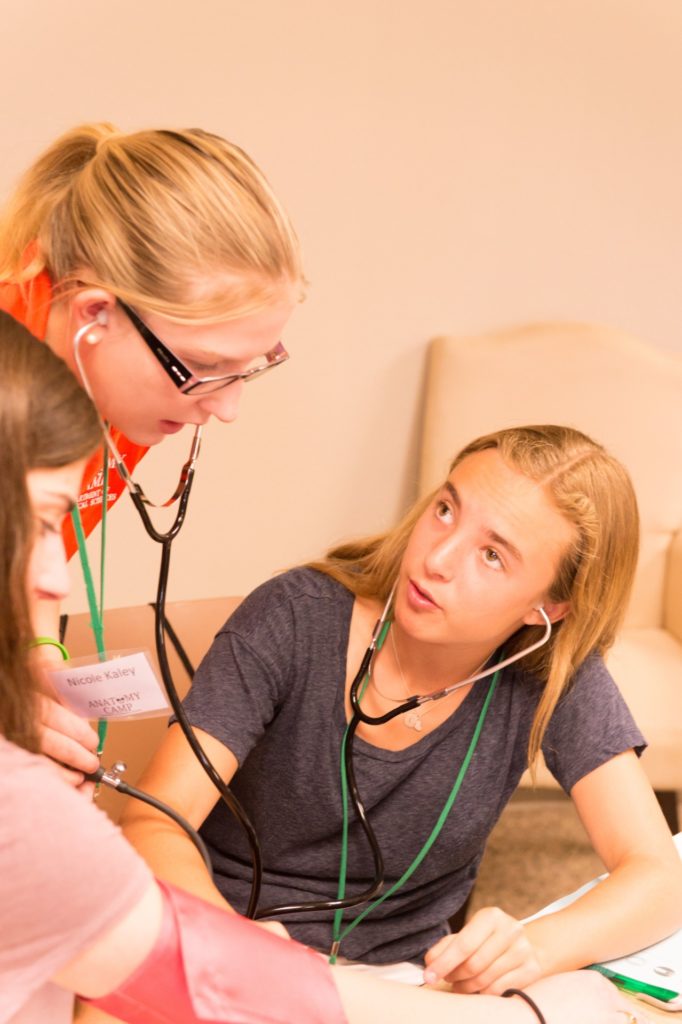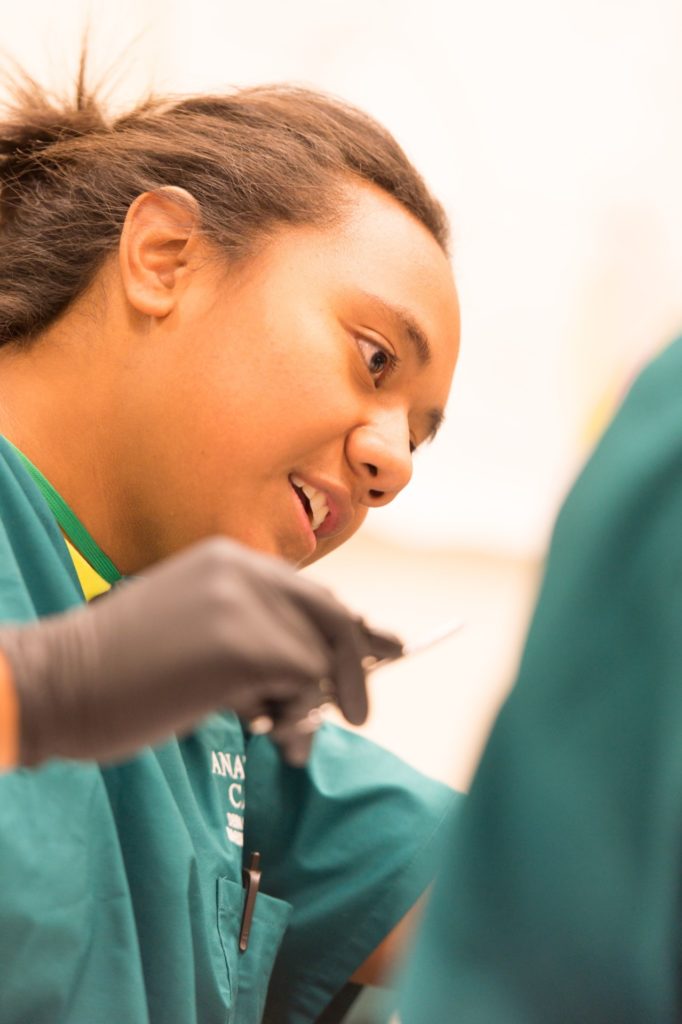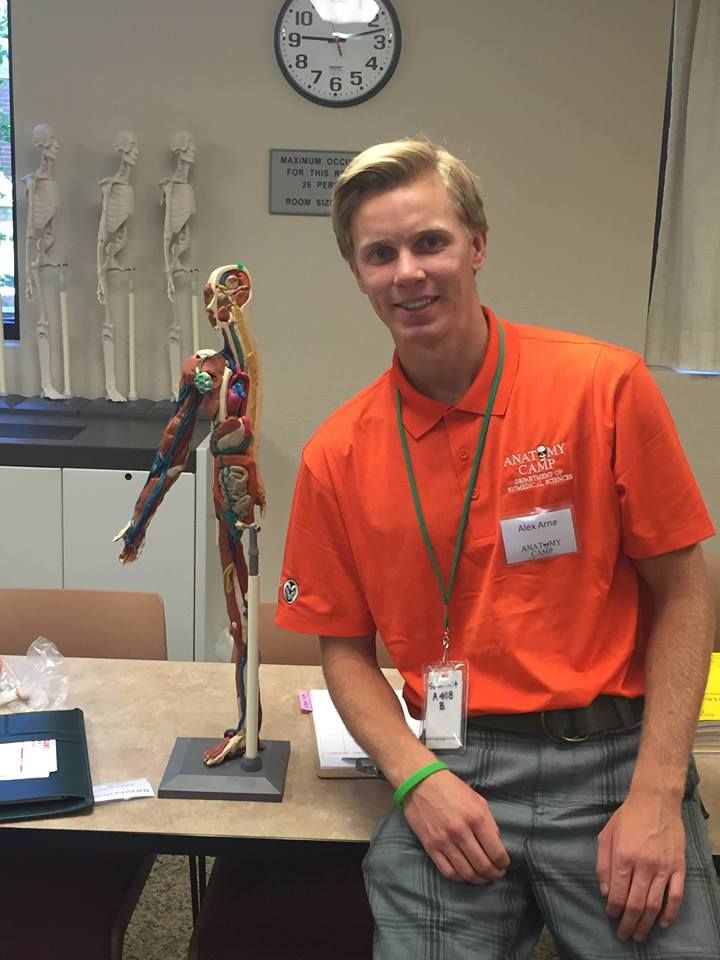
High-schoolers in bright green scrubs huddle to discuss a medical stumper: What caused a 46-year-old man’s liver failure?
To answer the question, the students draw upon knowledge and hands-on experience – including examination of a human cadaver and organs – that they’ve gained during a week at Colorado State University’s first Anatomy Camp. The students have traveled from across Colorado and the nation for a weeklong immersion in human gross anatomy instruction that will help direct their college studies and, for some, could be a first step toward careers in health and medicine.
“Trying to solve these case studies was intimidating at first,” said Sara Brodsky, a junior from Winter Park, Fla. “I’m not used to having to ask so many questions to get to the answer. It’s been different and challenging, but it’s getting easier as the week goes on.”
Through that critical-thinking process, visiting students determined the 46-year-old man had Cirrhosis of the liver, a progressive disease in which healthy tissue is replaced with scar tissue.
It was one of many cases students considered during the first session of CSU Anatomy Camp July 10-16; the second camp session is set July 24-30. By month’s end, about 50 students from eight states will have attended the fully booked camp sessions.
A sign of things to come
Faculty and graduate students in the Department of Biomedical Sciences are leading the camp in a project that could grow significantly in years to come, as the department undertakes plans to construct a state-of-the-art Health Education Outreach Center. The center, in early planning stages, would comprise a new wing of the CSU Anatomy-Zoology Building with laboratories dedicated to student training in human gross anatomy and neuroanatomy. Groundbreaking is not yet set.

CSU human anatomy programs for decades have attracted aspiring doctors and health professionals, in part because the university gives undergraduate students the rare chance to closely study and work with human cadavers, an opportunity that provides an incomparable look at the human body in its healthy and diseased states. The planned CSU Health Education Outreach Center would offer such learning not only to more undergraduate students, but to high-schoolers and to medical students through collaboration with the University of Colorado School of Medicine; it would be linked to life-sciences outreach and education at the National Western Center in Denver.
“The Health Education Outreach Center will have brand-new facilities for the study of human anatomy and human neuroanatomy,” said Tod Clapp, an assistant professor in the Department of Biomedical Sciences and head of its human anatomy program. “These facilities will rival the best medical schools in the U.S. and will allow us to serve more students.”
The first-ever session of CSU Anatomy Camp offered a preview of what’s to come, while also providing high-schoolers with exceptional anatomy instruction, excursions into the Rocky Mountains and a taste of campus life. In addition to attending college-level lectures and labs, visiting students stayed in CSU residence halls, hiked to well-known Horsetooth Rock, went whitewater rafting and visited historic Old Town Fort Collins.
A rare chance to study human cadavers
The 25 students at the first session were divided into small groups. At the beginning of the week, each group received a central question from a medical case study and was challenged to answer it at week’s end using information gained from interactive anatomy lessons. These lessons included the rare opportunity to examine human cadavers, which CSU acquires after people elect, before death, to donate their bodies to science education through the State Anatomical Board.
“We built Anatomy Camp around the idea of giving students a main challenge at the beginning of the week, in the form of a clinical case study, and having them gather and put together information in order to solve the case study and present their findings to the group at the end of the week,” said Clapp, a CSU 2016 Best Teacher awardee. “It’s a summer camp, but at the same time students gain valuable knowledge of anatomy and the skills needed to solve a novel problem.”
The rigorous schedule includes working with real anatomical specimens, dissecting animal specimens, studying cross-sectional anatomy, building anatomical clay models, and learning suture techniques, Virtual Human Dissector (VHD) software, and how to use stethoscopes and take blood pressure readings.
Top CSU anatomy students and graduates work as camp counselors, mentoring the visiting high-schoolers.
[masterslider id=”177″]
Students encouraged to be inquisitive
“High school is a good time to explore options and learn about the different opportunities that are out there,” said anatomy camp counselor Jolysa Gallegos, a 2016 graduate of the biomedical sciences master’s program. “These students are here because they want to be here and it shows.”
Many students were at first nervous, yet faculty, staff and counselors quickly put them at ease. “This week, be bold, creative, inquisitive, and ask questions,” Clapp encouraged the students. “You’re here to better understand yourself and how you learn, and we’re here to help.”
Anatomy camp counselor Derek George, a 2016 graduate of the biomedical sciences master’s program, said he was inspired to pursue medical school after exposure to human anatomy in high school. He now hopes to provide a similar experience for high-schoolers attending the CSU Anatomy Camp.
“I had a wonderful, enthusiastic teacher who talked about how much good people in medicine can do,” said George, who soon will start medical school at the University of Colorado. “I wanted to give back and potentially inspire these high school students to pursue a similar path.”
Campers interested in health and medicine

Many of those attending the first Anatomy Camp said they likewise are interested in medical school; they hoped the camp would accelerate their education.
“I came to Anatomy Camp because I want to be a battlefield trauma surgeon,” said Dylan Cowart, a sophomore from Fort Collins. His favorite activities included working with cadavers, suturing and participating in college-level lectures. “I learned so much this week about things I’ve never even thought about before.”
Anatomy Camp was more exploratory for other students.
“I don’t really know what I want to do after high school—that’s the main reason I came here,” said Joy Johnson, a sophomore from the Denver area. “I wanted to experience what it might be like to choose a path like this, and I’ve learned that I’m a lot less squeamish than I thought I would be. Now I’m thinking about going into physical therapy so that I can help people.”
Brodsky, the student from Florida, said the suturing clinic was her favorite camp activity.
“I want to be a pediatric orthopedic surgeon,” she said. “When I was in seventh grade, I had to have surgery on my knee and I loved my surgeon so much I decided I wanted to be just like her. I’m not sure where I’ll go to college, but after learning to suture and working with real cadavers, I feel like I’ve already gotten a good head start.”
Visit the Anatomy Camp website for more information.